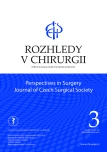Risk factors predicting cervical spine fracture on CT in craniocervical trauma − retrospective study
Authors:
O. Pánková 1; T. Rohan 1; M. Krtička 2; J. Kovařík 2; T. Andrašina 1
Authors‘ workplace:
Klinika radiologie a nukleární medicíny Fakultní nemocnice Brno a Lékařská fakulta Masarykovy univerzity, Brno
1; Klinika úrazové chirurgie Fakultní nemocnice Brno a Lékařská fakulta Masarykovy univerzity, Brno
2
Published in:
Rozhl. Chir., 2023, roč. 102, č. 3, s. 119-124.
Category:
Original articles
doi:
https://doi.org/10.33699/PIS.2023.102.3.119–124
Overview
Introduction: The study identifies risk factors predicting cervical spine fracture on CT based on information in the referral form.
Methods: All patients aged over 18 years with a CT scan of the head and cervical spine completed at the University Hospital Brno in the year 2019 to exclude any fresh trauma were included in the retrospective study. The analyzed potential risk factors included gender, age over 65 years, unconsciousness or impaired consciousness, mechanism of injury, paresthesia or plegia suspected to be associated with trauma, cervical spine pain, other neurological symptomatology, presence of cervical collar, presence of intracranial hemorrhage on head CT, and presence of skull fracture on head CT.
Results: In total, a cervical or upper thoracic spine fracture was described in 51 of 1177 patients (4.3%). Statistically significant risk factors for cervical spine fracture on CT scan were identified as mechanism of injury similar to car accident or jumping into water (OR 2.52; p=0.004), pain of the cervical spine (OR 1.81; p<0.001), paresthesia or plegia probably related to the injury (OR 2.81; p=0.024) and presence of cervical collar at the time of the CT of the cervical spine (OR 7.22; p<0.001). If cervical spine CT had been performed only in the presence of selected risk factors (age over 65 years and/or car accident and water jump and/or presence of unconsciousness and/or cervical spine pain), which were present in 77% of the patients, 50 of 51 fractures would have been captured (sensitivity 98%).
Conclusion: Significant risk factors associated with fracture findings on cervical spine CT can be identified based on the information provided in the referral form.
Keywords:
computed tomography – trauma – cervical spine – risk factors – X-ray
Sources
1. Milby AH, Halpern CH, Guo W, et al. Prevalence of cervical spinal injury in trauma. FOC. 2008;25:E10. doi:10.3171/ FOC.2008.25.11.E10.
2. Goergen S, Varma D, Ackland H, et al. Adult cervical spine trauma. Education modules for appropriate imaging referrals: Royal Australian and New Zealand College of Radiologists; 2015. [Internet]. 2015. Available from: https://www.ranzcr. com/our-work/quality-standards/education-modules.
3. Hasler RM, Exadaktylos AK, Bouamra O, et al. Epidemiology and predictors of cervical spine injury in adult major trauma patients: A multicenter cohort study. Journal of Trauma and Acute Care Surgery 2012;72:975–981. doi:10.1097/ TA.0b013e31823f5e8e.
4. Stiell IG, Clement CM, McKnight RD, et al. The Canadian C-spine rule versus the NEXUS low-risk criteria in patients with trauma. N Engl J Med. 2003;349:2510– 2518. doi:10.1056/NEJMoa031375.
5. Stiell IG. The Canadian C-spine rule for radiography in alert and stable trauma patients. JAMA 2001;286:1841. doi:10.1001/ jama.286.15.1841.
6. Hoffman JR, Wolfson AB, Todd K, et al. Selective cervical spine radiography in blunt trauma: Methodology of the national emergency X-radiography utilization study (NEXUS). Annals of Emergency Medicine 1998;32:461–469. doi:10.1016/ S0196-0644(98)70176-3.
7. Paykin G, O’Reilly G, Ackland HM, et al. The NEXUS criteria are insufficient to exclude cervical spine fractures in older blunt trauma patients. Injury 2017;48:1020–1024. doi:10.1016/j.injury.2017.02.013.
8. Uriell ML, Allen JW, Lovasik, et al. Yield of computed tomography of the cervical spine in cases of simple assault. Injury. 2017;48:133–136. doi:10.1016/j.injury. 2016.10.031.
9. Michaleff ZA, Maher CG, Verhagen AP, et al. Accuracy of the Canadian C-spine rule and NEXUS to screen for clinically important cervical spine injury in patients following blunt trauma: a systematic review. CMAJ. 2012;184:E867–E876. doi:10.1503/cmaj.120675.
10. Holmes JF, Akkinepalli R. Computed tomography versus plain radiography to screen for cervical spine injury: a meta-analysis. J Trauma 2005 May;58(5):902–905. doi:10.1097/ 01.TA.0000162138.36519.2A.
11. Mathen R, Inaba K, Munera F, et al. Prospective evaluation of multislice computed tomography versus plain radiographic cervical spine clearance in trauma patients. J Trauma 2007 Jun;62(6):1427–1431. doi:10.1097/01.ta. 0000239813.78603.15.
12. Brohi K, Healy M, Fotheringham T, et al. Helical computed tomographic scanning for the evaluation of the cervical spine in the unconscious, intubated trauma patient. J Trauma 2005;58:897–901. doi:10.1097/01.TA.0000171984.25699.35.
13. Diaz JJ, Gillman C, Morris JA, et al. Are five-view plain films of the cervical spine unreliable? A prospective evaluation in blunt trauma patients with altered mental status. J Trauma 2003 Oct;55(4):658– 663; discussion 663–664. doi:10.1097/01. TA.0000088120.99247.4A.
14. Daffner RH. Helical CT of the cervical spine for trauma patients: A time study. American Journal of Roentgenology 2001;177:677–679. doi:10.2214/ajr.177.3. 1770677.
15. Como JJ, Diaz JJ, Dunham CM, et al. Practice management guidelines for identification of cervical spine injuries following trauma: Update from the Eastern Association for the Surgery of Trauma Practice Management Guidelines Committee. J Trauma 2009;67:651–659. doi:10.1097/ TA.0b013e3181ae583b.
Labels
Surgery Orthopaedics Trauma surgeryArticle was published in
Perspectives in Surgery

2023 Issue 3
Most read in this issue
- Robotic distal pancreatectomy – the first experience
- Pneumoperitoneum, pneumomediastinum and subcutaneous emphysema following argon plasma coagulation treatment of colonic angioectasia
- Our experience with solitary fibrous tumors in the chest area
- Pancreaticoduodenectomy in patients with an unusual course of the hepatic artery
